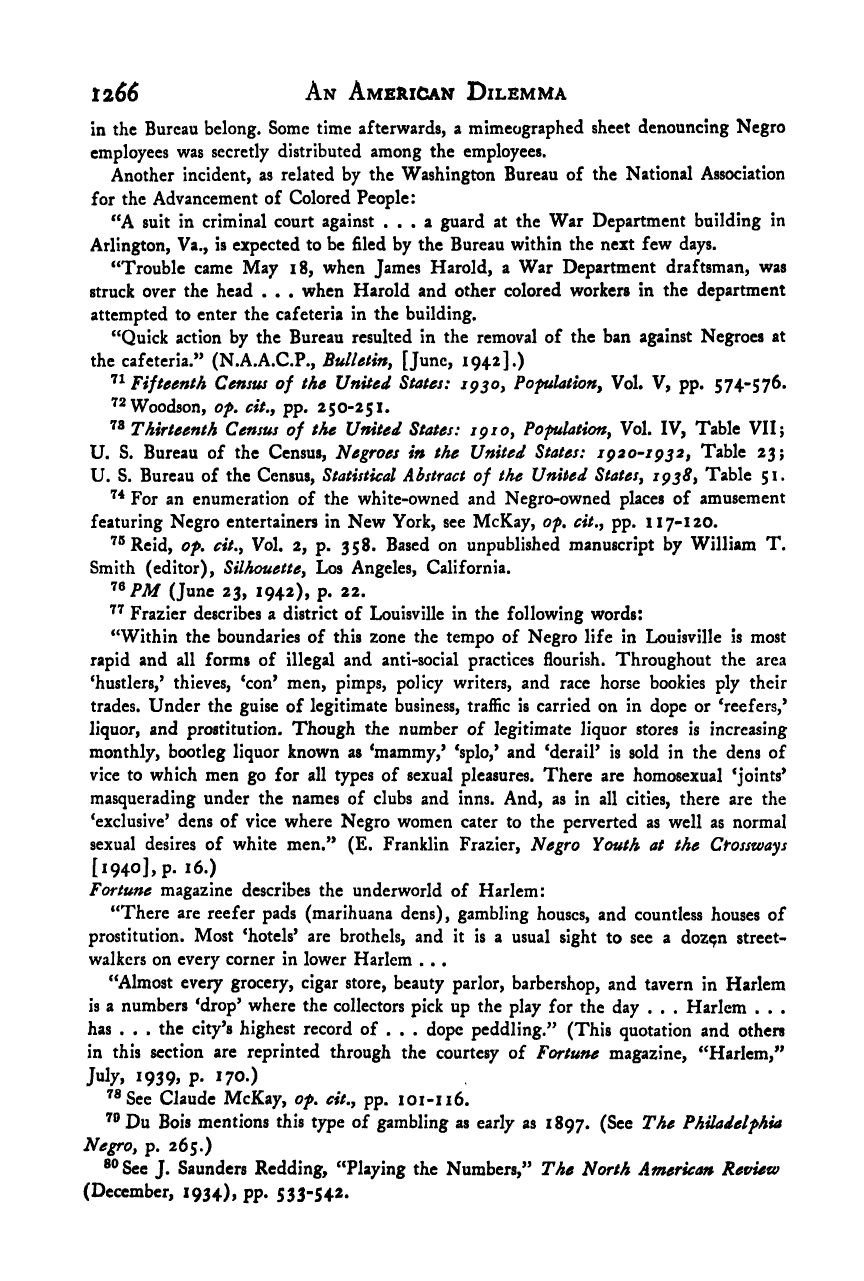Note: Gunnar Myrdal died in 1987, less than 70 years ago. Therefore, this work is protected by copyright, restricting your legal rights to reproduce it. However, you are welcome to view it on screen, as you do now. Read more about copyright.
Full resolution (TIFF) - On this page / på denna sida - Footnotes - Chapter 14

<< prev. page << föreg. sida << >> nästa sida >> next page >>
Below is the raw OCR text
from the above scanned image.
Do you see an error? Proofread the page now!
Här nedan syns maskintolkade texten från faksimilbilden ovan.
Ser du något fel? Korrekturläs sidan nu!
This page has never been proofread. / Denna sida har aldrig korrekturlästs.
1266 An Amehican Dilemma
in the Bureau belong. Some time afterwards, a mimeographed sheet denouncing Negro
employees was secretly distributed among the employees.
Another incident, as related by the Washington Bureau of the National Association
for the Advancement of Colored People:
“A suit in criminal court against ... a guard at the War Department building in
Arlington, Va., is expected to be filed by the Bureau within the next few days.
“Trouble came May i8, when James Harold, a War Department draftsman, was
struck over the head . . . when Harold and other colored workers in the department
attempted to enter the cafeteria in the building.
“Quick action by the Bureau resulted in the removal of the ban against Negroes at
the cafeteria.” (N.A.A.C.P., Bulletin^ [June, 1942].)
Fifteenth Census of the United States: 1^30, Population, Vol. V, pp. 574-576.
*^2
Woodson, of. cit.y pp. 250-251.
Thirteenth Census of the United States: igiOy Pofulation, Vol. IV, Table VII;
U. S. Bureau of the Census, Negroes in the United States: ig20’~jg32, Table 23;
U. S. Bureau of the Census, Statistical Abstract of the United States^ igsSy Table 51.
For an enumeration of the white-owned and Negro-owned places of amusement
featuring Negro entertainers in New York, see McKay, of. cit.y pp. 1 17-120.
^®Reid, Of. cit.y Vol. 2, p. 358. Based on unpublished manuscript by William T.
Smith (editor), Silhouette^ Los Angeles, California.
PM (June 23, 1942), p. 22.
Frazier describes a district of Louisville in the following words:
“Within the boundaries of this zone the tempo of Negro life in Louisville is most
rapid and all forms of illegal and anti-social practices flourish. Throughout the area
‘hustlers,’ thieves, ‘con’ men, pimps, policy writers, and race horse bookies ply their
trades. Under the guise of legitimate business, traffic is carried on in dope or ‘reefers,’
liquor, and prostitution. Though the number of legitimate liquor stores is increasing
monthly, bootleg liquor known as ‘mammy,’ ‘splo,’ and ‘derail’ is sold in the dens of
vice to which men go for all types of sexual pleasures. There are homosexual ‘joints’
masquerading under the names of clubs and inns. And, as in all cities, there are the
‘exclusive’ dens of vice where Negro women cater to the perverted as well as normal
sexual desires of white men.” (E. Franklin Frazier, Negro Youth at the Ctossways
[1940], p. 16.)
Fortune magazine describes the underworld of Harlem:
“There are reefer pads (marihuana dens), gambling houses, and countless houses of
prostitution. Most ‘hotels’ are brothels, and it is a usual sight to see a doz^n street-
walkers on every corner in lower Harlem . . .
“Almost every grocery, cigar store, beauty parlor, barbershop, and tavern in Harlem
is a numbers ‘drop’ where the collectors pick up the play for the day . . . Harlem . . .
has . . . the city’s highest record of . . . dope peddling.” (This quotation and others
in this section are reprinted through the courtesy of Fortune magazine, “Harlem,”
July, 1939, p. 170.)
^®See Claude McKay, of. cit., pp. 101-116.
^®Du Bois mentions this type of gambling as early as 1897. (See The Philadelfhia
J^egro, p. 265.)
®®See J. Saunders Redding, “Playing the Numbers,” The North American Review
(December, 1934), pp. S33-S42-
<< prev. page << föreg. sida << >> nästa sida >> next page >>